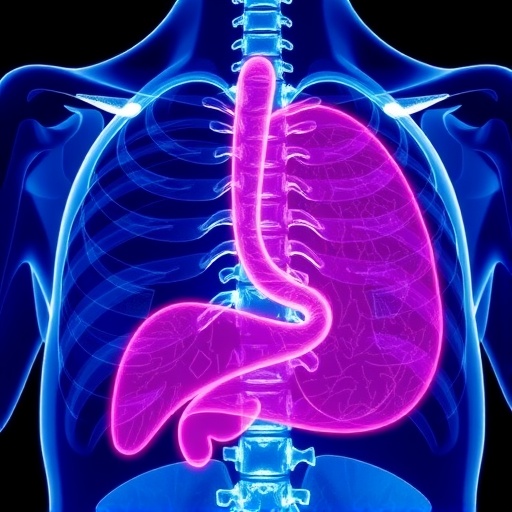Recent studies have underscored the complexities of advanced gastric cancer, one of the leading causes of cancer-related deaths worldwide. Among the various approaches to understanding its pathology, the relationship between programmed cell death ligand 1, commonly referred to as PD-L1, and the quantity of biopsy specimens collected has emerged as a pivotal focus area for researchers. A group of Japanese researchers led by Dr. T. Mizuno has found compelling evidence that suggests a significant correlation between PD-L1 expression levels and the number of biopsy specimens obtained from patients diagnosed with advanced gastric cancer.
The research team’s findings indicate that as the number of biopsy samples increases, PD-L1 expression levels exhibit a corresponding rise. This relationship holds critical implications for the management and treatment of advanced gastric cancer, particularly in terms of immunotherapy strategies. PD-L1, a vital immune checkpoint protein, plays a crucial role in regulating the immune system’s response to pathogens, including cancer cells. By binding to its receptor, PD-1, on T cells, PD-L1 effectively inhibits T cell activation and prevents them from attacking the cancerous tissues. Enhanced expression of PD-L1 in tumor cells can lead to immune evasion, making it an appealing target for cancer immunotherapy.
In their study published in the Journal of Cancer Research and Clinical Oncology, Mizuno and colleagues used a rigorous methodology to analyze biopsy specimens from numerous patients across different stages of the disease. The researchers employed immunohistochemistry techniques to evaluate PD-L1 expression levels, while also meticulously documenting the number of biopsy samples collected from each patient. This robust dataset provides a solid foundation for the authors’ conclusions, demonstrating that increased biopsy sampling enhances the likelihood of identifying high PD-L1 expression in tumor tissues.
The implications of these findings are vast and bear significant clinical relevance. In a landscape where immunotherapy is becoming increasingly important in oncology, understanding biomechanical pathways like PD-L1 expression can guide treatment strategies. For patients with advanced gastric cancer, knowing the PD-L1 status may directly influence treatment decisions, including the potential use of PD-1/PD-L1 inhibitors, which have shown promise in delivering favorable clinical outcomes.
Moreover, the research also opens a dialog on the methodologies employed in cancer diagnostics. Traditionally, the retrieval of a single biopsy has been the standard; however, Mizuno and his team offer compelling evidence that multiple biopsies can yield more comprehensive insights into the tumor’s immune landscape. This shift in approach could prompt a reevaluation of common clinical practices, potentially leading to more personalized treatment regimens based on a patient’s specific PD-L1 expression profile.
The findings are particularly important given that advanced gastric cancer often presents a heterogeneous landscape, characterized by different molecular and immune profiles across various tumor sites. This heterogeneity can complicate treatment decisions and outcomes. The team’s research suggests that integrating multiple tumor samples could provide a more accurate representation of the PD-L1 expression, thus ensuring that treatment approaches are robust and tailored to the individual patient’s cancer profile.
Furthermore, the study emphasizes the need for continuous research into how these findings can be translated effectively into clinical practice. As scientists, oncologists, and pathologists collaborate, future studies may delve deeper into whether the observed increase in PD-L1 expression truly correlates with therapeutic efficacy. Could increased PD-L1 levels signify greater responsiveness to immunotherapies? Could they also indicate a more advanced stage of immune evasion within the tumor microenvironment?
In addition to helping refine treatment protocols, understanding the relationship between PD-L1 expression levels and biopsy specimen quantity could also contribute to early detection efforts. As the cancer landscape continues to evolve with improvements in diagnostic imaging and molecular biology, the importance of obtaining an accurate tumor profile at the time of diagnosis becomes paramount.
Dr. Mizuno’s research team also cautions on the variability of PD-L1 expression observed among patients and different tumor locations. The expression levels are not static; they can change over time, especially as tumors adapt to various therapeutic interventions. This dynamic behavior of PD-L1 necessitates a more nuanced approach to its assessment, whereby timely and repeated biopsies may be warranted to capture the tumor’s evolving profile accurately.
This groundbreaking study can serve as a foundational piece in the ever-expanding puzzle of gastric cancer treatment landscape. The results align with the contemporary shift towards personalized medicine, urging a greater emphasis on the individual’s unique cancer biology rather than a one-size-fits-all approach. By advocating for the incorporation of multiple biopsy specimens as a standard practice, the paper expands the horizon of how future cancer therapies might be developed and optimized.
As current clinical trials continue to explore the effectiveness of PD-1 and PD-L1 inhibitors in advanced gastric cancer populations, it remains to be seen how these findings will influence their inclusion criteria and treatment plan customization. The ongoing quest to understand the intricacies of immune checkpoints paves the way for improved innovation, allowing the medical community to harness the body’s own defenses against malignancies.
In conclusion, Mizuno et al. provide a critical insight that underscores the importance of meticulous biopsy sampling practices in the evaluation of advanced gastric cancer. Their work not only elucidates the relationship between PD-L1 expression and biopsy quantity but sets the stage for further explorations into the immune landscape of tumors. As researchers build upon these findings, the hope remains that advancements in oncology can translate to improved patient outcomes and lives saved. The need for integrative strategies in cancer management has never been more pressing, and such studies are key to unlocking the therapeutic potentials that lie ahead.
Subject of Research: Relationship between PD-L1 expression and biopsy specimens in advanced gastric cancer.
Article Title: Relationship between programmed cell death ligand 1 expression and the number of biopsy specimens in advanced gastric cancer.
Article References: Mizuno, T., Narita, Y., Ishizuka, Y. et al. Relationship between programmed cell death ligand 1 expression and the number of biopsy specimens in advanced gastric cancer. J Cancer Res Clin Oncol 151, 206 (2025). https://doi.org/10.1007/s00432-025-06255-1
Image Credits: AI Generated
DOI:
Keywords: PD-L1, advanced gastric cancer, biopsy specimens, immunotherapy, personalized medicine.




